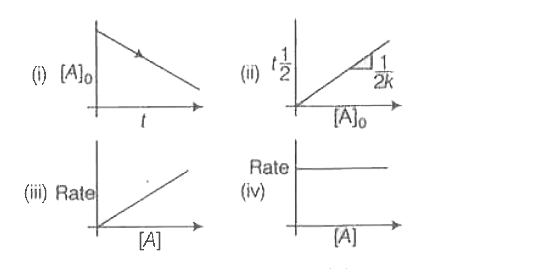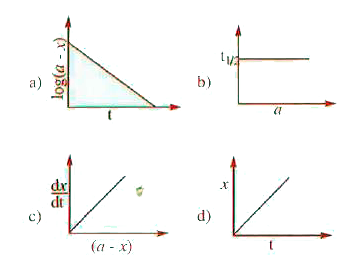Which of the following are the correct representations of a zero order reaction where A represents the reactant ?
 Solution in Telugu
Solution in Telugu
I,II,III
I,II,IV
II,III,IV
I,III,II
The correct Answer is:B
(i) ,(ii) .(iv )
In zero order R' n
T12∝[A]02K
Topper's Solved these Questions
Similar Questions
Assertion (A) Atoms with completely filled and half-filled subshells are stable.
Reason (R ) Completely filled and half filled subshells have symmetrical distribution of electrons and have maximum exchange energy.
The correct answers isView SolutionThe energy of an electron in the 3rd orbit of H- atom ( in J ) is approximately.
View SolutionWhich of the following represents zero order reaction ?
05:37View SolutionWhich of the following graphs is correct for a zero order of reaction?
05:25View Solutionशून्य कोटि की अभिक्रिया के लिए निम्नलिखित में से कौन-सा सूत्र सही है?
03:20View SolutionWhich of the following graphs represent a first order reaction (a=initial concentration of reactant, x=concentration of reactant consumed, t=time)
 04:11View Solution
04:11View SolutionWhich of the following is correct for zero and first order reactions respectively, where 'a' is initial concentration of the reactant ?
03:49View SolutionWhich of the following is correct representation of the variation of half - life with initial concentration of a zero order reaction ?
View SolutionWhich of the following graph is correct for zero order reaction?
05:37View SolutionWhich of the following realation is correct for zero order reaction?
02:53View SolutionWhich of the following formulas is correct for the reaction of zero order?
View SolutionWhich of the following graphs are correct for a zero order reaction?
02:39View SolutionWhich of the following curves represents a second-order reaction? ('a' is the concentration of the reactant)
03:04View SolutionWhich of the following curves represents a zero order reaction ? [ (a-x) =reactant concn.]
01:38View SolutionWhich of the following is correct for zero and first order reactions respectively, where 'a' is initial concentration of the reactant ?
02:08View Solution

